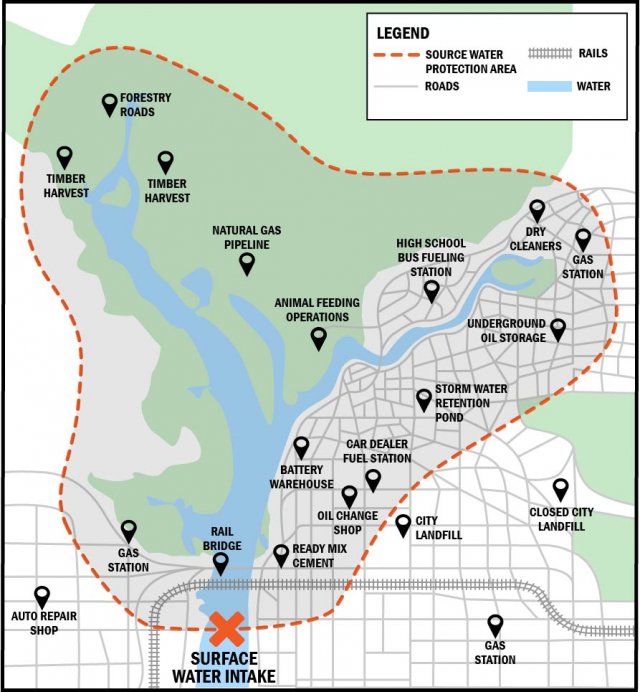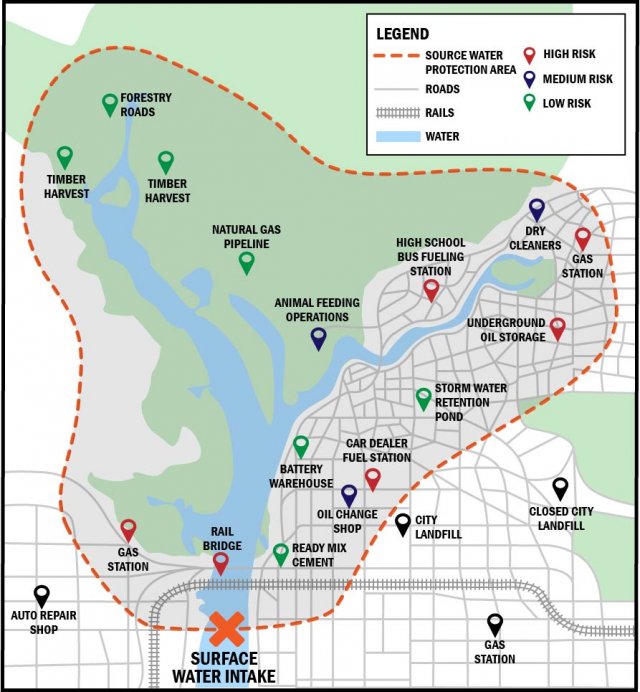Source Water Assessments
On this page:
- State Source Water Assessment Programs (SWAPs)
- Consumer Confidence Reports
- Technical Service Providers



Source water assessments (SWAs) are studies or reports that generate information about potential contaminant sources and the potential for systems to be impacted by these sources. A completed source water assessment for a public water system often includes
- A delineated source water protection area (SWPA) and/or zone(s) of concern;
- An inventory of potential contaminant sources and characterization of land activities located within the source water protection area;
- A determination and/or ranking of the public water system’s susceptibility to contamination by identified significant contaminant sources; and
- A process for informing the public about threats identified in the assessment and what they mean for the water system.
Public water systems and source water protection partners can use the SWA to inform development of an action plan and implement measures to protect and/or enhance source water, such as public education, watershed conservation, adoption of best management practices, or land use restrictions. SWAs can also guide water supply planning efforts and coordination of emergency responses.
State Source Water Assessment Programs (SWAPs)
The 1996 Amendments to the Safe Drinking Water Act (SDWA) emphasized the importance of pollution prevention to protect the safety of drinking water supplies and required states to create a Source Water Assessment Program (SWAP) for all public drinking water systems. State drinking water programs were required to:
- Identify the land area(s) which provide water to each public drinking water source in their state;
- Complete an inventory of existing and potential sources of contamination in those areas;
- Determine the susceptibility of each drinking water system to contamination; and
- Distribute the results of the assessment to water users and other interested entities.
The purpose of the 1996 program requirements was to provide communities with the information needed to formulate and implement protection measures. By the early 2000s, source water assessments were completed for all public water systems. The statute did not explicitly require tribal water systems to complete assessments, but EPA completed many tribal water system assessments and recommended that each tribe implement such a program to the extent appropriate resources were available.
The 1996 SDWA Amendments do not require states to update source water assessments periodically. However, some states opt to implement state-specific policies requiring periodic evaluations and/or updates of assessments. States may provide access to public water system source water assessment reports on their websites or will respond to information requests for these reports. Visit your state’s Drinking Water Primacy AgencyEXIT website for more information.
You may also find assessment information in your drinking water provider's annual Consumer Confidence Report (CCR). Often referred to as an annual drinking water quality reports, CCRs provide Americans with information about their drinking water quality, as well as information on the availability of an assessment and a brief summary describing the water providers susceptibility to contamination.
Technical Assistance Providers
Water systems can seek assistance to complete source water assessments and plans. Environmental consulting firms, state public health and environmental agencies, federal agencies (e.g., U.S. Department of Agriculture (USDA), the USDA Natural Resources Conservation Service (NRCS), United States Geological Survey (USGS), or the EPA), state cooperative extension services, rural water associations, circuit riders (i.e., water system technical advisors), and environmental or engineering departments of local universities may all provide technical assistance and/or data to complete delineations, assessments, and plans.
- EPA Technical Assistance Partners
- EPA Regional Source Water Protection Programs
- Tribal Assistance Providers
- State Rural Water Associations
- Rural Community Assistance Partnership (RCAP)
- Environmental Finance Centers
- USDA Grassroots Source Water Protection Program
- State Drinking Water Primacy Agencies
